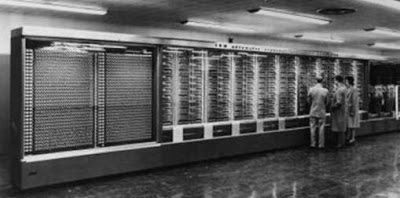Education
One of the first computer was the Mark I. It was invented by Dr. Howard Aiken of Harvard University in association with International Business Machine in 1944. It was not an electronic computer rather it was electromechanical computer.
The computer nicknamed ‘Mark I’ was based on the concept of Charles Babbage’s Analytical Engine. Sometimes it was referred to Harvard Mark I. Harvard is added to distinguish this machine from Mark I at the University of Manchester and from other Mark I machine.
The Mark I Computer also known as automatic controlled calculator, this was first fully automatic calculating machine design by Howard.
The size of this computer was huge and has a thousand moving parts. Its design was very complex, but it was quite reliable. Mark I contained more than 750,000 parts, including switches, relays, rotating shafts, and clutches.
Grace Murray Hopper who at that time worked with Aiken later developed a piece of software that would translate an entire set of programmer’s instruction, written in a high level symbolic language, into the machine’s language.
Harvard Mark I Computer

- About Artificial Intelligence(al)
Artificial intelligence (AI) is the intelligence exhibited by machines or software. It is also the name of the academic field of study which studies how to create computers and computer software that are capable of intelligent behavior. Major AI researchers...
- History Of Microsoft Spreadsheet
The first spreadsheet on a personal computer was called VisiCalc (short for visible calculator) and was created by Daniel Bricklin and Bob Frankston in 1978. Bricklin, student at Harvard Business School, had to perform some analytical tasks as part of...
- History Of Apple Computer
Apple Computer was founded on April 1, 1976. The company was born out of the desire of two spirited innovators, Steve Wozniak and Steve Jobs. They began operating out of garage building the Apple I, which some claim to be the first personal computer to...
- Early History Of Artificial Intelligence
In the 800s BC, the Iliad described the winged Talos, a bronze automation forged by Hephaestus to protect Crete. Aristotle’s logic was developed and expanded on by later philosophers, mathematicians and logicians. The Aristotelian approach to logic...
- Jacquard Loom By Joseph Marie Jacquard
After French revolution woven silk, especially silk with elaborate brocades or design, was in demand both in France and abroad. Weaving designs into silk was an extremely time consuming process. A skilled weaver and drawboy using the best equipment available...
Education
Harvard Mark I Computer
One of the first computer was the Mark I. It was invented by Dr. Howard Aiken of Harvard University in association with International Business Machine in 1944. It was not an electronic computer rather it was electromechanical computer.
The computer nicknamed ‘Mark I’ was based on the concept of Charles Babbage’s Analytical Engine. Sometimes it was referred to Harvard Mark I. Harvard is added to distinguish this machine from Mark I at the University of Manchester and from other Mark I machine.
The Mark I Computer also known as automatic controlled calculator, this was first fully automatic calculating machine design by Howard.
The size of this computer was huge and has a thousand moving parts. Its design was very complex, but it was quite reliable. Mark I contained more than 750,000 parts, including switches, relays, rotating shafts, and clutches.
Grace Murray Hopper who at that time worked with Aiken later developed a piece of software that would translate an entire set of programmer’s instruction, written in a high level symbolic language, into the machine’s language.
Harvard Mark I Computer

- About Artificial Intelligence(al)
Artificial intelligence (AI) is the intelligence exhibited by machines or software. It is also the name of the academic field of study which studies how to create computers and computer software that are capable of intelligent behavior. Major AI researchers...
- History Of Microsoft Spreadsheet
The first spreadsheet on a personal computer was called VisiCalc (short for visible calculator) and was created by Daniel Bricklin and Bob Frankston in 1978. Bricklin, student at Harvard Business School, had to perform some analytical tasks as part of...
- History Of Apple Computer
Apple Computer was founded on April 1, 1976. The company was born out of the desire of two spirited innovators, Steve Wozniak and Steve Jobs. They began operating out of garage building the Apple I, which some claim to be the first personal computer to...
- Early History Of Artificial Intelligence
In the 800s BC, the Iliad described the winged Talos, a bronze automation forged by Hephaestus to protect Crete. Aristotle’s logic was developed and expanded on by later philosophers, mathematicians and logicians. The Aristotelian approach to logic...
- Jacquard Loom By Joseph Marie Jacquard
After French revolution woven silk, especially silk with elaborate brocades or design, was in demand both in France and abroad. Weaving designs into silk was an extremely time consuming process. A skilled weaver and drawboy using the best equipment available...
